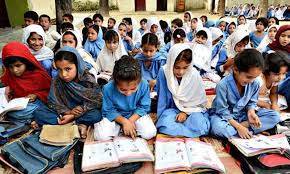
In 2020, just before the onset of the Covid-19 pandemic, i joined elementary and secondary education, KP, as a certified teacher. Upon entering the educational system, I encountered pervasive learning poverty within every class and through discussions with teachers across KP province it became evident that this is widespread across the 35,000 schools in the region.
Education reports and policy papers highlight that KP is not the only province grappling with this education crisis; rather, it's a nationwide issue. Each province in Pakistan faces similar challenges, with a significant portion of students lacking fundamental skills in areas such as reading, writing, and numeracy. There is consensus that Pakistan has a learning poverty rate of 79%, which means that most of the students (by the age of ten) cannot read, write, and perform basic numeracy.
Approximately 42 million boys and girls are enrolled in schools and the government and development finance institutions pay scarce attention to what they learn there. The Human Capital Review (World Bank Group) 2022 is disheartening as the gripe about out-of-school children took most of the space and poor quality of education is not properly addressed.
This trend has persisted since Alif Ailaan (a civil society organization) highlighted the issues of low enrolment and retention rates across the country. Lack of imagination on the part of education experts and development-sector consultants is not an oddity in Pakistan. This is the logical outcome of not sitting down with educators and school leaders serving in public schools.
While the plight of millions of out-of-school children rightfully captures attention, it is imperative not to overlook the alarming statistic of 79% learning poverty in the schools. More than half of the children in 6-10 grades struggle to comprehend simple sentences in English or Urdu, let alone perform basic arithmetic operations. It is projected that learning poverty in Pakistan could escalate to as high as 90% in the coming decades if effective interventions are not implemented to address the situation.
Despite numerous attempts at education reform by successive federal governments, the problems persist. The latest experiment, the SNC, not only increased the volume of content but failed to address learning poverty and weak pedagogical skills.
Examining the polls manifesto of various political parties reveals the antipathy for the public education, with only PPP and PTI mentioning education reforms without demonstrating the determination or expertise to tackle low enrolment and learning poverty. One is at loss how the economy would be turned around without significant strides in substantial literacy rate.
Turning to potential reforms within the budgetary constraints, new provincial governments could focus on several key areas.
First, strengthening teacher education institutions and providing them with adequate financial resources is paramount. This could involve engaging erudite teacher educators, quality pre- and in-service training and implementing monthly class-room inspections. Provincial Institute of Teacher Education in KP and training institutions in other provinces lack excellent master trainers and stimulating learning material for trainees. Class-room demonstrations and continuous professional development must be integrated into teacher education.
Secondly, the provincial governments must abolish private admissions for Bachelor’s and Master’s in education that does not involve real learning in subjects like pedagogy, child psychology, classroom and assessment,. Many teachers pass these examinations by providing irrelevant and wrong answers, leading to degrees that hold little value. (Open universities are particularly culpable in this regard.)
Thirdly, reducing the syllabus by consolidating subjects such as Islamiat, Quranic Studies, and Arabic, as well as geography and history, could alleviate the burden on students. Currently, students in KP and Punjab face an excessive workload of 11 books, which, combined with other activities like tuition and Quran learning in the evening, leaves little time for foundational skills like numeracy, reading, and writing. However, implementing such changes requires collaboration among stakeholders, which may take years to materialise.
Fourthly, district education officers must ensure thorough compliance with the standards set by teacher education institutions, encompassing teacher qualifications, teaching methodologies, and curriculum requirements. This includes monitoring learning outcomes to ensure they reflect adherence to these standards, such as academic achievement and curriculum mastery. Weak oversight on the part of district education administration can contribute to discrepancies in education quality and assessment benchmarks, undermining the effectiveness of educational initiatives.
While addressing the issue of millions of out-of-school children remains crucial, the government must also prioritise combating learning poverty. Streamlining teacher education and professional qualifications can help ensure that passionate educators are deployed to schools without unnecessary bureaucratic hurdles. The incoming government must recognize the significance of addressing learning poverty, as the prosperity of the nation hinges upon the education of its 45 million school-going children.

